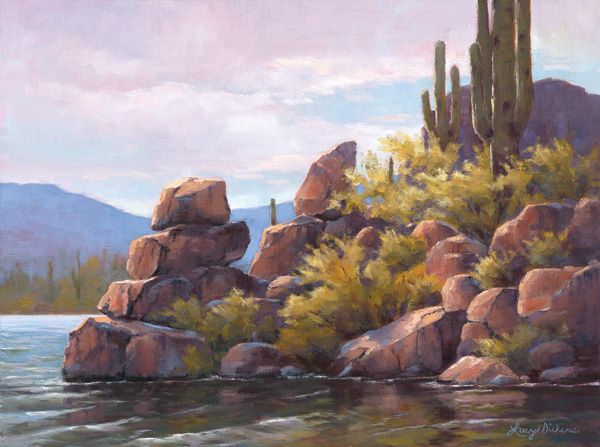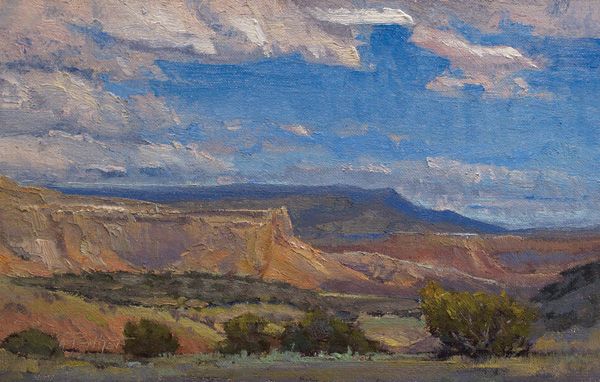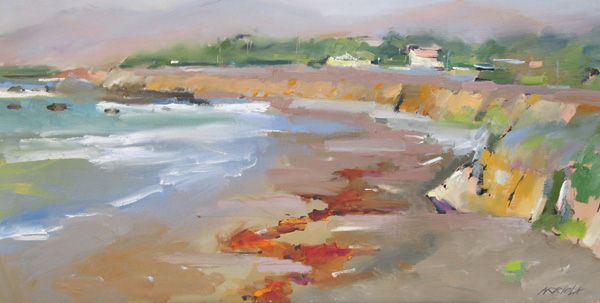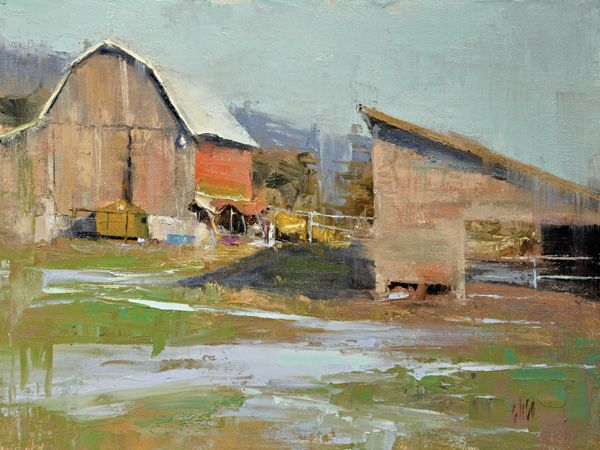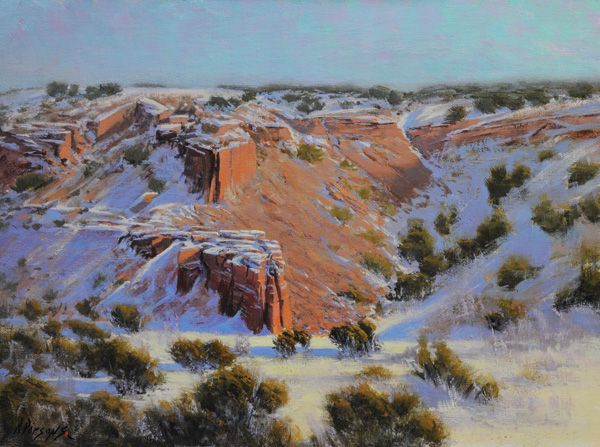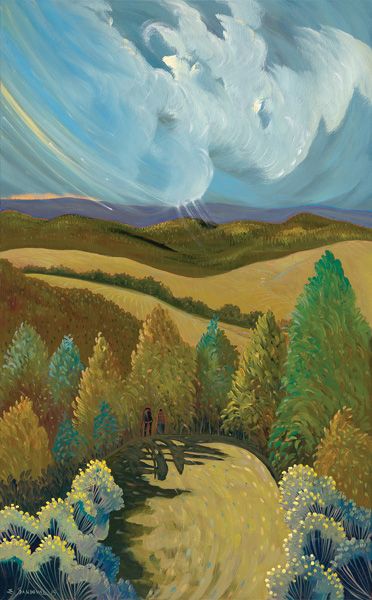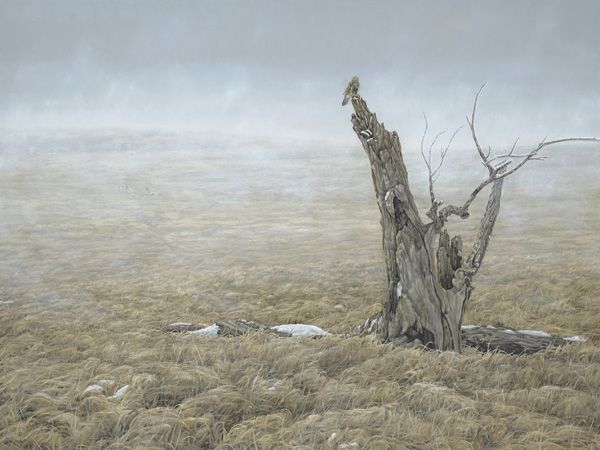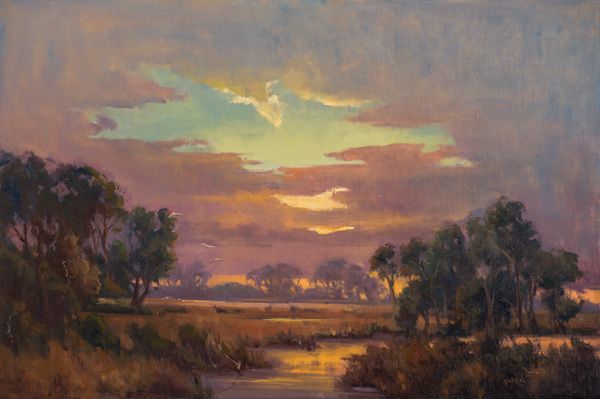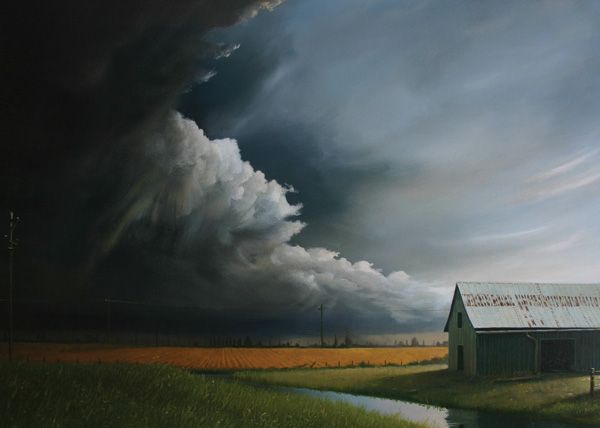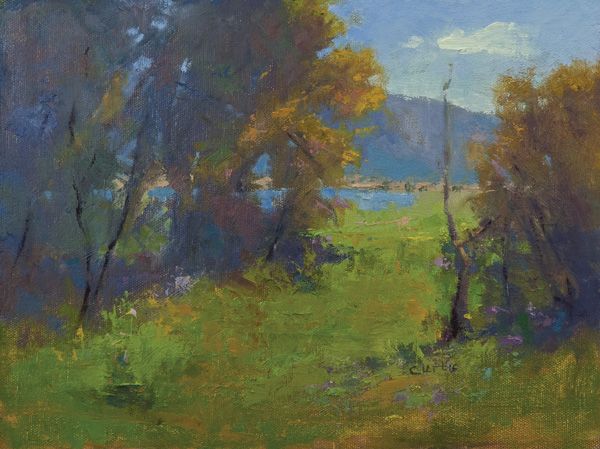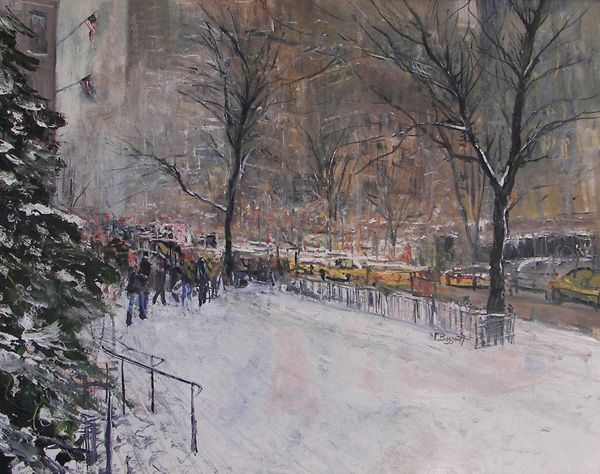Meet 11 artists who focus on painting the landscape
This story was featured in the August 2015 issue of Southwest Art magazine. Get the Southwest Art August 2015 print issue or digital download now–then subscribe to Southwest Art and never miss another story!
Lucy Dickens
Richard Prather
Martin Arriola
Mike Wise
Roger Parsons
Ed Sandoval
Colin Starkevich
Mary Garrish
Andy Eccleshall
Linda Curtis
Frank Baggett
Lucy Dickens
From the cobblestone streets of Tuscany to the rim of the Grand Canyon, Lucy Dickens discovers moments in time that take her breath away. These are the encounters that propel her to share her artistic vision. She refers to such encounters as “God moments.” When she portrays them on canvas, her desire is to bring hope, light, and peace to viewers. “I want to evoke feelings of serenity and grace, to transport you to another place and time—to the mystery and fleeting moments of beauty,” Dickens says.
As the daughter of a watercolorist and photographer, the artist spent her early years exploring the outdoors. The family camped and hiked throughout the Southwest. Dickens continued her love of travel with her own husband and children. These experiences left her with a passion for the natural world as well as the manmade worlds of far-off locales. Lately when she travels, she not only gathers reference material for paintings but also creates a story to accompany each work, which conveys her reflections in words.
Dickens has long been drawn to works by great American landscape painters such as Thomas Cole and Frederic Church, admiring their mastery of atmosphere and light. For Dickens the interplay of light and shadow is a constant source of inspiration. “I love the magic hour just before dusk when the shadows grow long and the light caresses the landscape before me,” she says. Dickens is represented by Xanadu Gallery, Scottsdale, AZ, and www.lucydickensfineart.com. —Bonnie Gangelhoff
Richard Prather
For Richard Prather, art wasn’t a principal influence growing up but was something he naturally gravitated toward. With a love of the outdoors, he enrolled in range and wildlife science at Texas Tech University, later transferring to Texas A&M University and graduating in 1981 with a degree in wildlife and fisheries science. He then spent 30 years working as a biologist. Prather took art workshops in college and afterward, but it wasn’t until his daughters went to college that he pursued his art full time, focusing on realistic wildlife paintings. “I was interested in wildlife and pursued a photorealistic approach. [But] my work lacked emotion, energy, and originality,” he says. “I knew a change was in order, and fortunately it came in my first plein-air workshop. It was an awakening.”
Since then Prather has worked to capture his lifelong love of nature through the majestic landscapes of the Southwest, painting mostly en plein air. It’s the texture of the land that calls to him. “I love texture in the landscape. It can be subtle or it can scream out in bright contrast, and I’m drawn to it,” he says. “I hope to share those moments in time and space when I’ve found myself in awe of the beauty of nature.” Prather’s work can be found at InArt Gallery, Santa Fe, NM; Marta Stafford Fine Art Gallery, Marble Falls, TX; Purple Sage Gallery, Albuquerque, NM; and www.richardprather.com. —Joe Kovack
Martin Arriola
Los Angeles-based painter Martin Arriola finds inspiration for his paintings in the diverse landscapes of California. From coastal scenes to mountain peaks, Arriola captures the views en plein air. But his artistic pursuits weren’t always quite so scenic: He started his career drawing automotive parts for Pep Boys. He then studied illustration at Los Angeles Trade-Technical College and the Art Center College of Design in Pasadena. Later he accepted a job at the toy company Mattel, working as a product designer for 32 years. All the while he continued to paint, even setting up a workshop and gallery at Mattel for employees to study art.
It was after reading Richard Schmid’s book Alla Prima that Arriola discovered the splendor of painting on location. He began to take workshops with artists like Calvin Liang and Ken Auster and eventually retired from commercial art to focus on painting. Now Arriola captures the beauty of the land in oil, watercolor, and gouache. “I like to jump around [in media],” he says. “The variety helps me.” Whether he’s painting a coastal scene in Monterey or a rugged mountainous expanse, he employs a loose, painterly approach to engage the viewer. “You want to bring the viewer into your work,” he says. “You don’t have to render every leaf—let the viewer finish it. Let them use their imagination.” Arriola’s work can be found at www.martinarriola.com. —Joe Kovack
Mike Wise
One afternoon while attending an art show with a friend, Mike Wise—who was then a securities broker for Bank of America—realized that he would like to try his hand at painting. Soon he was spending his spare time learning everything he could about the craft. “I don’t have any formal art education at all,” he says, but he devoted himself to learning.
After years of studying with excellent western painters, Wise came to a couple of realizations that dramatically altered his work. First, he realized that he had to step back from everything he had been taught in workshops and books and take the technique of painting into his own hands because his work was looking like other artists’ works. Later, he realized that the paintings still lacked something. “It’s about trying to bring a sense of that place to the canvas,” he says. “Trying to convey a sense of depth. If you don’t convincingly portray that, the painting falls flat and doesn’t have life.”
Today Wise renders highly impressionistic depictions of the rural landscape that speaks to him. “Art is a language,” he says. “And as an artist becomes more proficient, their vocabulary expands, conveying ideas more efficiently, more effectively.” And as a means of communication, his paintings require the viewer to finish the thought. “I give them enough to latch onto; they get to bring their experience to it.”
Wise’s work can be found at Abend Gallery, Denver, CO; Cole Gallery, Edmonds, WA; Fredericksburg Art Gallery, Fredericksburg, TX; Sage Creek Gallery, Santa Fe, NM; and www.mikewisestudio.com. —Laura Rintala
Roger Parsons
Before Texas painter Roger Parsons began to paint the landscape, he was a student of math and science. He earned a bachelor’s degree in civil engineering from the Air Force Academy and then a master’s degree in civil engineering from Purdue University in 1983. While working at his first Air Force job in Albuquerque, he met with a friend to paint the Rio Grande Gorge near Taos. “I learned I needed to draw better. So I took workshops in portraits and still lifes and then landscape,” Parsons says. “I naturally gravitated to the landscape—rocks, trees, and clouds, that’s what I love to paint.”
In 2011 Parsons suffered a stroke, forcing him to pause his burgeoning painting career. Rehabilitation took nearly a year, but with help from his wife—as well as inspiration from his mentor, Arturo Chávez, and advice from painter Dan Mieduch—Parsons overcame his limitations and emerged a stronger painter. Now he finds inspiration in the landscapes of Texas, Arizona, and New Mexico, bringing to life the canyons, rock formations, cliffs, and valleys. “I want [my work] to be mesmerizing,” he says. “My compositions naturally tend to be meditative, the kind of scenes you can linger in and contemplate. I don’t want just landscapes with a hill and a tree and a road—I want strong action and drama in the color in my composition.” Parsons’ work can be seen at www.rparsons.fineartstudioonline.com. —Joe Kovack
Ed Sandoval
Inspiration comes easy for New Mexico artist Ed Sandoval—it surrounds him every day. Sandoval makes his home in Taos, NM, which is nestled in the magnificent Sangre de Cristo mountains. “There is always a symphony of color here,” he says. “We have the most gorgeous skies and cloud formations in the world.”
The artist captures the world around him with splashes of bold color and graphic shapes that evoke the energy of the American Southwest. Sandoval likes to joke that his style could be described as “reckless impressionism.” One could also describe it as a marriage of impressionism and expressionism. “I mix both styles together like you would make an enchilada dinner using both green and red chilies,” Sandoval says.
Sandoval is one of the featured artists in September at Saks Galleries in Denver, CO. Over the years his paintings have been juried into numerous museum exhibitions, including shows at the Eiteljorg Museum of American Indians and Western Art in Indianapolis, IN, and the Phippen Museum in Prescott, AZ. Sandoval is represented by Saks Galleries, Denver, CO; Grand Bohemian Gallery at El Monte Sagrado, Taos, NM; and Studio de Colores Gallery, Taos, NM. —Bonnie Gangelhoff
Colin Starkevich
Colin Starkevich has good reason to feel proud. At just 25 years old, he currently has a solo exhibition at the prestigious Royal Alberta Museum in Edmonton, Alberta, Canada (on view through August 23). Titled Glimpses of the Grasslands, the exhibition features more than 60 paintings by Starkevich. While some may see the Canadian grasslands as “an open space full of nothing,” Starkevich believes the region possesses an abundance of naturally beautiful elements. One of his missions: to capture this beauty on canvas. “I feel the grasslands are overlooked by many people, which leaves the area more vulnerable to destruction when it comes to the conservation of the land and its wildlife,” he says.
Starkevich is a firm believer that personal experiences result in the best paintings, whether he is painting the landscape or wildlife. “I want every one of my paintings to have a soul of its own which will speak differently to different people,” he says. “But I want everyone who views my work to feel deeply connected to the place or animal within the painting.” Starkevich is represented by The Gallery on Main, Lacombe, Alberta, Canada. —Bonnie Gangelhoff
Mary Garrish
As a native Floridian, landscape painter Mary Garrish feels drawn to capture wetlands and marshes, towering cumulonimbus clouds, and the varied trees of her home state. Garrish is both a plein-air and studio painter, and she says that painting en plein air is her textbook. “I am gathering information, opening my eyes to what nature is putting before me,” she says. “If you have enough patience, nature will re-veal the incredible things that are out there in the landscape.”
Garrish comes to fine art from a very different background. “I was an ear, nose, and throat physician,” she says, but she felt a strong inclination toward creating art. So she retired from her practice and threw the energy and passion she had given to medicine into the study of painting. “I started off taking workshops and trying to find my voice,” she says. “I was lucky to work with Scott Christensen, and I consider him my mentor.” Today Garrish paints large pieces—measuring up to 5 feet—of scenery in her home state as well as the far-flung landscapes of her travels. And after beginning her artistic pursuits as “an uncontrolled colorist,” the artist finds herself moving toward tonalism.
Garrish is represented by J.M. Stringer Gallery of Fine Art, Vero Beach, FL, and Bernardsville, NJ; Corse Gallery & Atelier, Jacksonville, FL; Stellers Gallery, Ponte Vedra Beach, FL; and www.marygarrishfineart.com. —Laura Rintala
Andy Eccleshall
The misty atmosphere and pastoral hills of Stafford, England, inspired Andy Eccleshall as a child. He loved to draw, and he began creating architectural illustrations and landscape paintings at an early age, selling his first painting at 16. After Eccleshall graduated from the former Exeter Faculty of Arts and Design in southern England in 1992, he experimented with various genres, but the landscape prevailed as his principal subject. “There’s something about [painting the] landscape that is therapeutic. Where I grew up there was a lot of interesting light and misty scenes that were always a challenge to capture,” he says. “I tried portraiture and other things, but the landscape always felt like where I belonged.”
In 1994 Eccleshall came to the United States for a job painting murals in Connecticut; he moved to Seattle in 2000 with his future wife. Since then Eccleshall has run his own mural company while also focusing on his personal art. His landscapes result from inspiration gathered during his travels and everyday life, and he aims to capture the dramatic quality of light in a heightened realistic style. “Capturing those really intriguing scenes is what keeps me going—the lights and the darks, contrasts and subtleties,” he says. “I like to challenge myself. I’m not a huge fan of really pretty landscapes. I enjoy the slightly unusual.” Eccleshall’s work can be seen at his show in September at Cole Gallery, Edmonds, WA, as well as at Painter’s Chair Fine Art Gallery, Coeur d’Alene, ID, and www.andyeccleshall.com. —Joe Kovack
Linda Curtis
In the late 1980s, Linda Curtis was working as a service agent for a car dealership in Oregon when she met a customer who would help change her life. Curtis and the customer, a local watercolor artist, struck up a conversation about art, and soon after, she was taking classes every Saturday with the artist, learning to paint the landscape. She quit her job in 1995 to pursue art full time, and she stuck with watercolor until the early 2000s. “I couldn’t get enough textures out of the watercolors,” she says. “I took a workshop with Richard McKinley, who’s now my friend and mentor, and we did plein-air landscapes in oil and pastel. That got me all the texture I needed.”
Working mostly in oils now, Curtis’ subjects range from the rivers and canyons of Oregon to the colorful desert of Arizona. Spending time in both areas has helped push her art forward, teaching her to capture the distinct colors of the contrasting environments. “My intention is to be more impressionistic, rather than spell everything out. I think of the landscape more abstractly than a realist,” she says. “It’s the texture of the land, the trees, and the little dances of light filtering on the grasses and through the trees—that’s what draws me to my subjects.” Curtis’ works can be found at Art Presence Art Center, Jacksonville, OR; The Gallery in Mount Shasta, Mt. Shasta, CA; and www.lindacurtisstudio.com. —Joe Kovack
Frank Baggett
Prominently displayed on Frank Baggett’s website is this declaration from the artist: “You cannot paint water unless you get your feet wet.” Nearby is a photograph of Baggett standing in a creek in front of his easel, painting the scene before him. The words and the picture say a lot about Baggett’s approach to landscape painting. On a hot summer day, this particular spot, not far from his farm in Waverly, TN, might be the best place to find him, he says. And in fact, many of his landscape works capture quiet, intimate places close to home. “Oftentimes I will walk past a place that I have crossed many times in the past, but this time the sunlight strikes it, and it suddenly becomes an inspiration,” Baggett says.
The artist is equally gifted at depicting the noisy, chaotic streets of an urban metropolis like New York City. What the landscapes and urban scenes share in common is Baggett’s impressionistic style, which features juicy paint applied thickly with a palette knife to create strong textures. “I also use light to enhance an object, whether it is a tree or a building—an element that can add more drama to a piece,” Baggett says. The artist is represented by Reinert Fine Art, Charleston, SC; SouthWind Gallery, Topeka, KS; Arts of Daycholah Gallery, Green Lake, WI; Weiler House Fine Art Gallery, Fort Worth, TX; and Art in Miniature, Tubac, AZ. —Bonnie Gangelhoff
Featured in the August 2015 issue of Southwest Art magazine–click below to purchase:
Southwest Art August 2015 print issue or digital download Or subscribe to Southwest Art and never miss a story!
MORE RESOURCES FOR ART COLLECTORS & ENTHUSIASTS
• Subscribe to Southwest Art magazine
• Learn how to paint & how to draw with downloads, books, videos & more from North Light Shop
• Sign up for your Southwest Art email newsletter & download a FREE ebook






